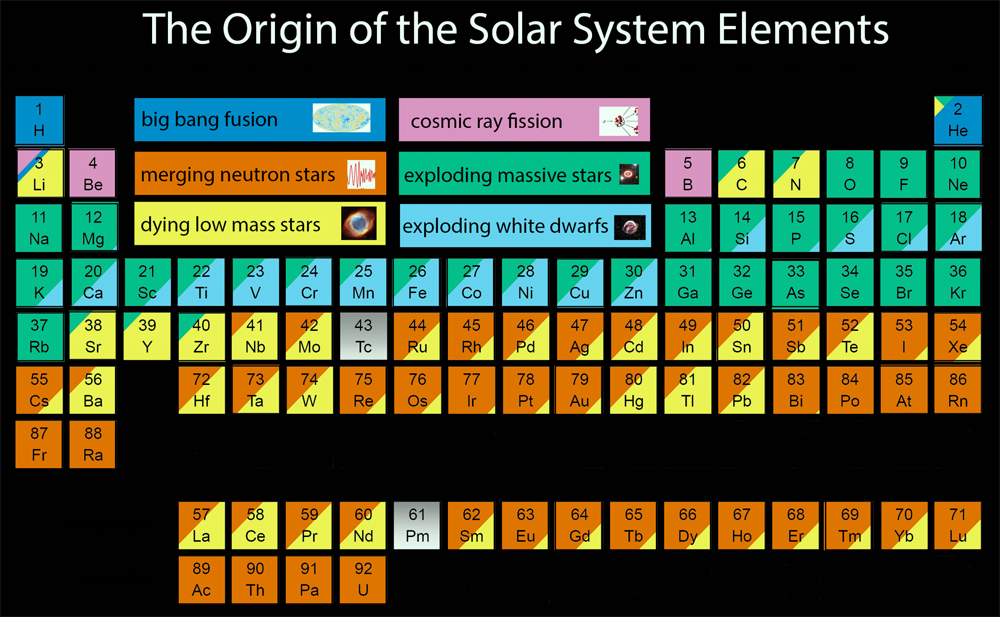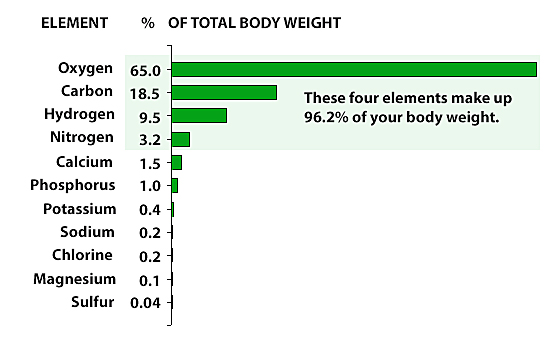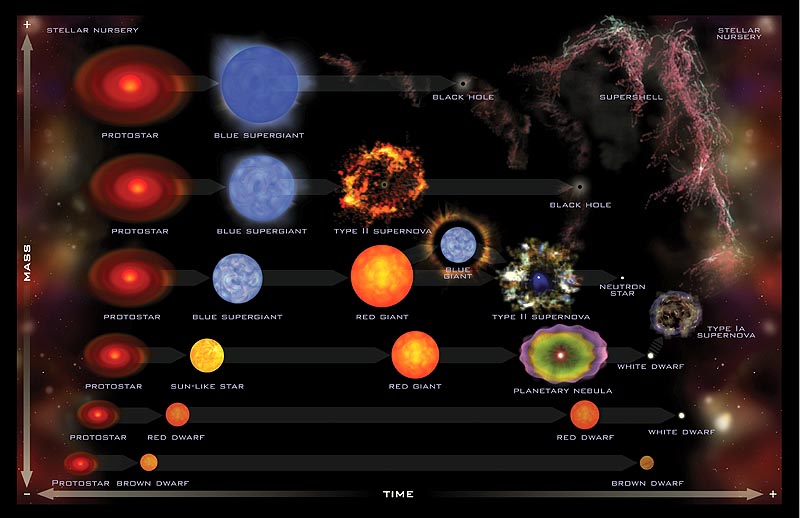Colophon
Stellar Evolution | |
|---|---|
| In this EBook we discuss how stars form and evolve throughout their lifetime. | |
| Tags | Astronomy, Stellar evolution, EM-spectrum, spectral lines, star formation, molecular cloud, star burst, proto-star, nucleosynthesis, fusion, Orion nebula, Crab nebula, multi-wavelength, plasma, ionisation, nucleus, electron, strong nuclear force, proton, neutron, proton-proton cycle, CNO cycle, Hertzsprung-Russell diagram, main sequence, red dwarf, giant, red giant, super giant, blue giant, white dwarf, core collapse, supernova, neutron star, black hole, luminosity, spectral class, brown dwarf, black dwarf, shell fusion, triple-alpha process, planetary nebula, electron degeneracy, neutron degeneracy, Chandrasekhar limit, Pauli exclusion principle, hydrogen, helium, carbon, oxygen, neon, magnesium, silicon, sulphur, iron, pulsar, event horizon, schwarzschild radius, type Ia, type Ib, type Ic, type II, light curve, metallicity, thermal runaway, horizontal branch, asymptotic giant branch, Gaia spacecraft, cosmic alchemy, cosmic ray fission. |
| Prerequisites | Our EBook Stellar Radiation (spectra, HR-diagram) |
| Author(s) | EV |
| First Published | June 2008 |
| This Edition - 3.0 | November 2018 |
| Copyright |
|
Introduction
Compared to the human life span, everything in the Universe seems stationary and constant. We need to think at another time scale to understand that everything moves in orbits and that stars come and go; a time scale of evolution. A human life span, and in some cases even the existence of the human race as a whole, is too short to actually observe dynamic processes in the Universe.
 While we cannot wait to see the evolution of one star, we can study many stars in various stages of their evolution, and thus learn about the whole sequence. Modern observations, in particular in wavelengths outside the visible spectrum and also from observatories in space, have contributed very much to our understanding of stellar evolution, although research in stellar evolution remains very much at the forefront of modern astrophysics.
While we cannot wait to see the evolution of one star, we can study many stars in various stages of their evolution, and thus learn about the whole sequence. Modern observations, in particular in wavelengths outside the visible spectrum and also from observatories in space, have contributed very much to our understanding of stellar evolution, although research in stellar evolution remains very much at the forefront of modern astrophysics.
In this module we will discuss how stars are born, live their life - some live much shorter than others - and how there are different ways in which they end their existence.
The material from which stars are made never disappears. This module will also illustrate how stars are formed from the remains of previous stars and how the Universe can be considered as a giant "recycle factory".
Before continuing this EBook, it is advisable to first read our EBook “Stellar Radiation” to learn about the Electro-Magnetic spectrum, spectroscopy and the Hertzsprung-Russell diagram.
Star formation – How it begins
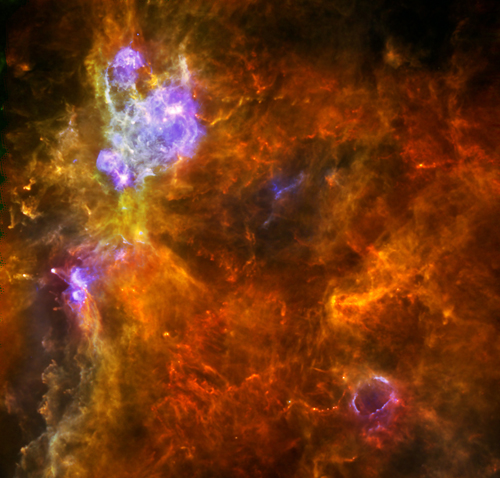 Herschel telescope image of a star forming region in Cassiopea. Credit and further info here Galaxies, including our own Milky Way galaxy, contain vast amounts of gas and dust in inter-stellar space in the disk region. Regions called Giant Molecular Clouds (GMC’s) can extend over hundreds of light years and contain as much material as millions of Suns.
Herschel telescope image of a star forming region in Cassiopea. Credit and further info here Galaxies, including our own Milky Way galaxy, contain vast amounts of gas and dust in inter-stellar space in the disk region. Regions called Giant Molecular Clouds (GMC’s) can extend over hundreds of light years and contain as much material as millions of Suns.
The gas is predominantly Hydrogen, the most abundant element in the Universe, but it also contains other gasses. The dust particles are microscopic and are largely composed of Carbon and Silicates. Generally these inter-stellar regions are cold enough for molecules to exist. Under influence of high-energy radiation from young hot stars, the gas can become ionised and it then emits light in various ways, forming emission nebulae.
The process of star formation begins when a region of gas and dust becomes gravitationally unstable because a part of the cloud compacts and increases in pressure. This can be the result of a collision of different clouds, or be due to the shock wave of a supernova explosion (see below) or strong radiation of a nearby young massive star.
On a grand scale this can happen when neighbouring galaxies interact and massive “star burst regions” are formed, often as a result of a galaxy merger.
Once this compression occurs, gravity can cause further contraction which results in rotating clouds of compressed gas called proto-stars, in which the internal pressure slows but cannot prevent further collapse under gravity. At this stage bi-polar jets can appear on both sides of the rotation axis of the proto-star. Most stars form in groups in the same region and thus will have similar age.
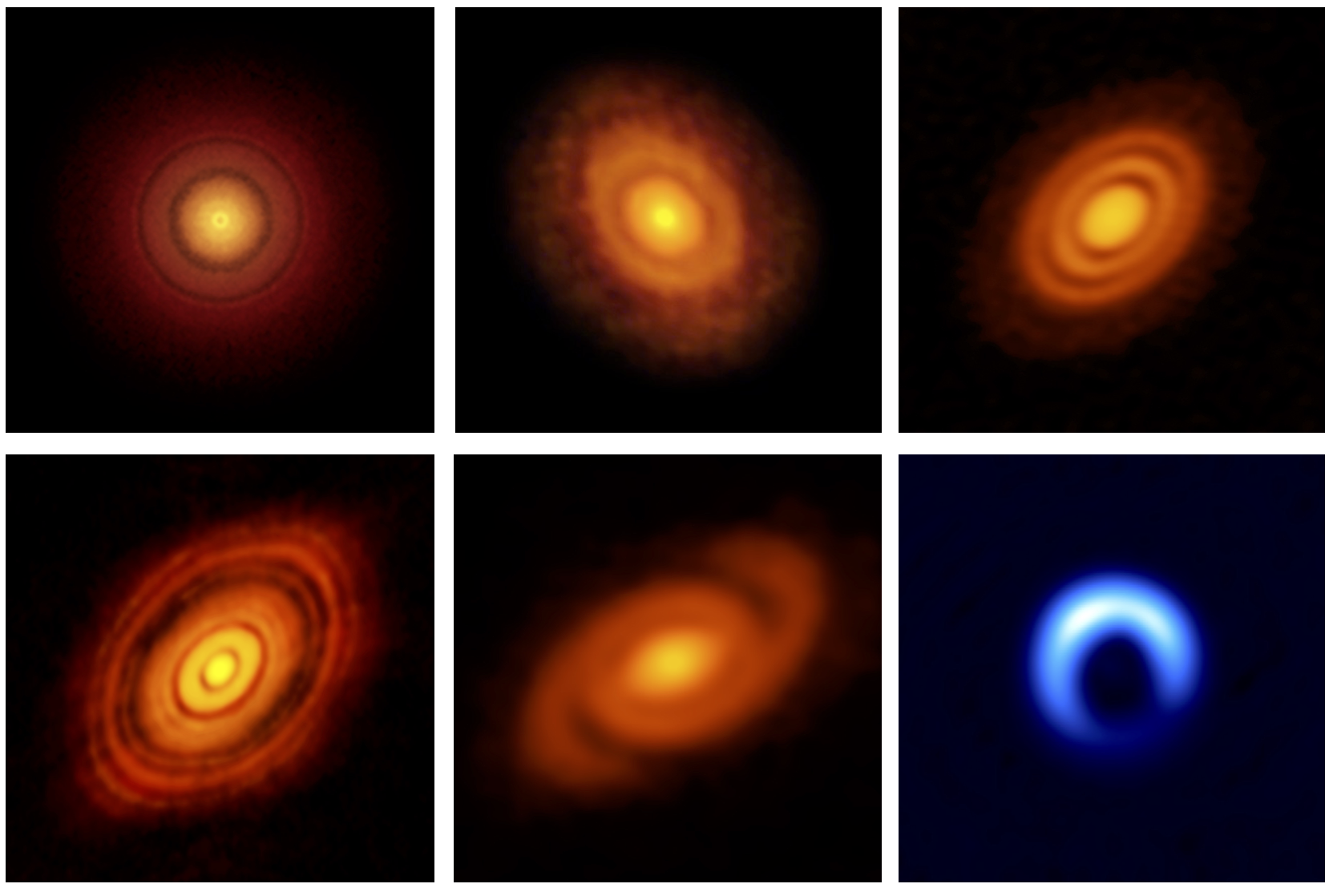 ALMA images of proto stars. Credit and further info here
ALMA images of proto stars. Credit and further info here
This process of star formation occurs in very dynamic and often violent conditions of turbulence and high energy radiation and is very hard to model. Very often proto-stars are blown apart before they can actually start nuclear fusion, so star formation is a hit-and-miss process. Stars can also become too big to ever form a stable star and they blow themselves apart as soon as nuclear fusion starts, resulting in one or more large stars and/or new clouds from which stars can form.
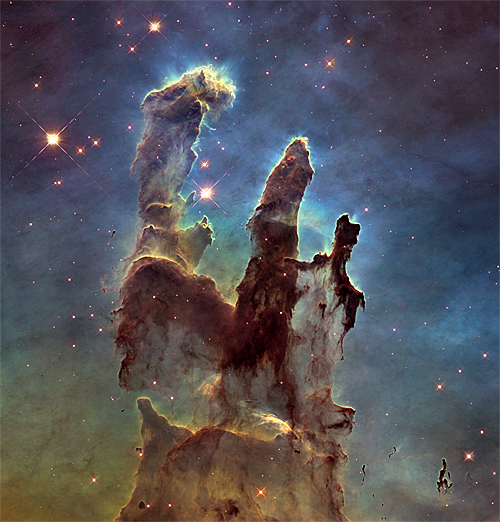 |
| Probably the most iconic image ever produced by the Hubble Space Telescope is the image dubbed Pillars of Creation, showing a star forming region in the Eagle Nebula. Image credit. HubbleCast video. |
Ignition
When the proto-star collects more material from the area around it (accretion), the internal pressure can become so high that nuclear fusion starts. This is the moment that a proto-star becomes a real star, fusing Hydrogen into Helium.
The explosive start of nuclear fusion blasts away material around the young star and can possibly start the process of planet formation in a disk region surrounding the young star.
The formation of a star of Solar mass can take a few million years, but very massive stars can develop in as little as one hundred thousand years.
Orion Nebula – Case study
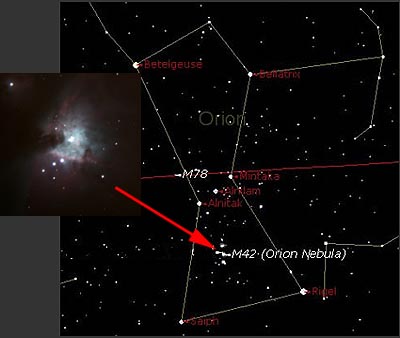 Credit. Note that this is the Northern Hemisphere view
Credit. Note that this is the Northern Hemisphere view
and that Orion is "upside down" on the Southern Hemisphere
The Orion nebula (or Messier 42) is one of the closest regions for studying the process of star formation. It can give us an idea how our own Sun and solar system formed and it is also the nearest location to us where we can see the most massive stars form. It is an ideal location to study star formation in a multitude of different gas and dust environments.
As viewed from Earth the Orion nebula is located in the Orion constellation. It lies at a distance of 1,500 light years and is about 35 light-years in diameter. The brightest stars near the centre (the Trapezium stars) have formed from massive clouds and these stars are so hot that they illuminate the remaining gas and dust.
Hundreds of stars have been found that are in various stages of formation in this nebula. Also many proto-planetary disks are seen that reveal how solar systems form.
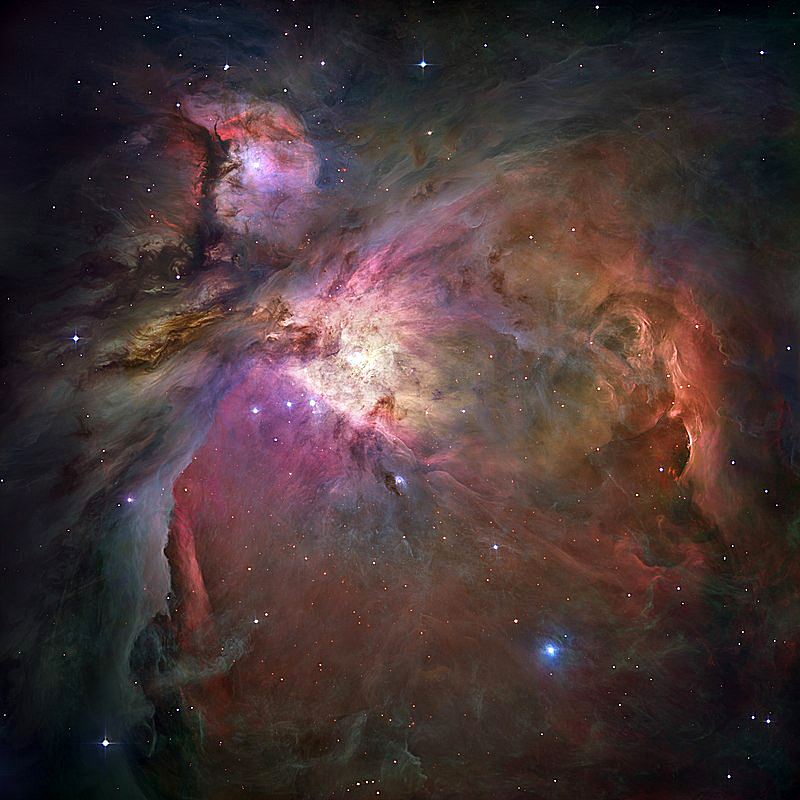 |
| Watch a Slide show here. |
| More Information |
| Further reading here |
|
Take a trip through the Orion Nebula and a 360 degree version It is important to note with these animations that the true scale of what you see is incomprehensible. These “fly through’s” are at super-luminous speeds and therefore very unrealistic. If you would really fly there you would see almost nothing because everything is so far apart, and it would take you much more than your life time to get through. |
|
Watch a detailed lecture on star formation in general and especially in the Orion Nebula (edited from here). It also emphasises the use of multi-wavelength astronomy to study star formation. (from 18:50 until 1:02:00 or edit and upload.) |
Nuclear fusion – University’s Powerhouse
If you wish, catch up on the basics of Atoms and Chemical Elements here
Throughout the Universe and ever since its beginning with the Big Bang, energy is predominantly generated by nucleosynthesis, which is a term used to describe a variety of reactions of nuclear fusion.
Through most of the star's life, energy is produced by hydrogen fusion through a series of steps that ultimately convert hydrogen into helium. Most of the time the inner region of the star, the core, is the only location in the star that is hot enough for this fusion process.
Inside the star, due to the high temperature, atoms are stripped off their electrons and only the bare nucleus can exist. So when we say that hydrogen fuses to helium, only the nuclei of these elements are involved. So what is hydrogen fusion?
Hydrogen fusion – the basics
| Heating up Gas and dust contracts due to self-gravity. This increases temperature and pressure in the centre of the cloud. |
|
| Plasma Increasing temperature means that the speed of the particles increases. With increasing temperature hydrogen and other atoms are loosing their electrons and a plasma is created mainly consisting of free protons and electrons. |
|
| Strong Nuclear Force Protons have equal charge and therefore repel each other. At very high temperature protons can collide and undergo nuclear fusion: they stick together and form other particles and energy is released. This happens when protons come so close together that the strong nuclear force overcomes the electric repelling of the protons. When this happens a star is born and nuclear fusion will continue. |
|
| Fusion creates Energy When protons collide other nuclei are formed while a little mass (m) is “lost” due to nuclear binding energy; the new nucleus has slightly less mass than the individual constituents together. This "lost" mass is converted into energy (E) according to E=mc2. Since c2 is a very large number, a very small amount of mass will produce a large amount of energy. |
 |
|
p-p Cycle
Image credit: Wikipedia |
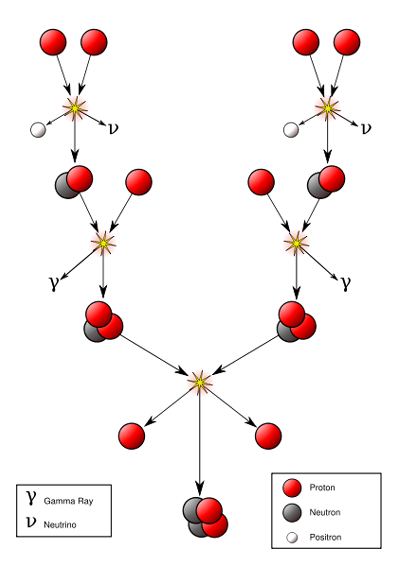 |
|
CNO-cycle
Image credit: Wikipedia |
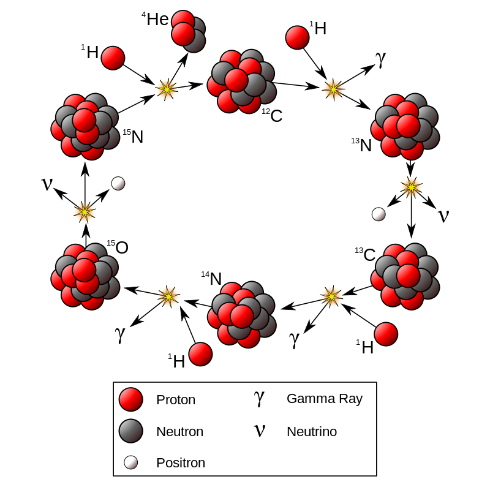 |
| Dynamic Equilibrium The explosive force of the fusion counters the contraction due to self-gravity and a dynamic but stable balance is reached. |
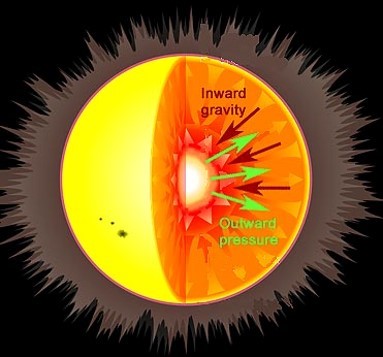 |
|
Life time |
|
Terminology Often in astronomy the process of nuclear fusion is described as “burning”, e.g. “hydrogen burning”. This term is very misleading because burning relates to a chemical reaction involving oxygen. |
Further in this EBook we will discuss the end stages in the life of stars of different mass.
In preparation for that, a good overview of the most important nuclear reactions (nucleosynthesis) that happen in stars is given here.
Further Reading:
How stars are born: video
Going deeper, including history of discovery of fusion
Main Sequence
Very much of the further life cycle of the star depends on how massive the star is. The mass of a star determines the temperature of its photosphere, and this in turn determines its luminosity, or energy output.
|
Read more about luminosity, spectral class and the Hertzsprung-Russell diagram in our EBook “Stellar Radiation”. |
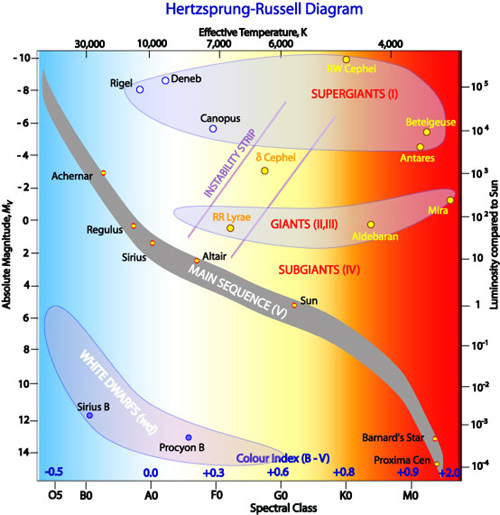 Hertzsprung-Russell diagram plots stars according to temperature and spectral class (horizontal) and luminosity (vertical).
Hertzsprung-Russell diagram plots stars according to temperature and spectral class (horizontal) and luminosity (vertical).
Source.Astronomers use the Hertzsprung-Russell diagram in which stars are plotted according to temperature (horizontal and increasing towards the left) and luminosity or absolute magnitude (vertical). A diagonal band across the diagram, called the Main Sequence, contains all stars that are fusing hydrogen into helium, as all stars do during most of their lifetime. The young star now has taken up a position in the main sequence, according to its temperature and luminosity. It is the “adulthood” of the star.
Temperature is directly related to Spectral Class which has been explained in our EBook “Stellar Radiation”. We already introduced the HR-diagram there. The main classes of stars are from most luminous to faint, O,B,A,F,G,K,M.
Stars that are ten times more massive than the Sun are over a thousand times more luminous than the Sun. However, it is all relative: the Sun is ten times brighter than a star half its mass. The more massive a main sequence star, the brighter and bluer it is. For example, Sirius (spectral class A1), is more massive than the Sun (spectral class G2), and is noticeably bluer. Spica (spectral class B1) is about ten times more massive than the Sun, and has a luminosity 2,300 times that of the Sun. On the other hand, Proxima Centauri (spectral class M5), our nearest neighbour, is less massive than the Sun, and is thus redder and less luminous.
The O and B-type stars are the most massive and therefore the highest up (and furthest to the left) in the main sequence. They fuse hydrogen much faster than lower mass stars and are therefore on the main sequence for a much shorter time. O-type stars live only a few million years whereas M-type stars live up to 100 billion years. The bigger stars have a lot more hydrogen to fuse, but they do so much faster (much higher core temperature) and thus live much shorter.
The great thing about the HR-diagram is that once we have located a star in the main sequence, we know pretty much every other basic property of that star, such as mass, luminosity, size, temperature, colour and lifetime.
| Please read our EBook “Stellar Radiation”, especially from page 13. You can also watch this lecture on Main Sequence stars and the HR-diagram (first 15 minutes) |
Further below in this EBook we will learn to use the HR-diagram to follow the entire life cycle of a star, according to its classification and we will go off the main sequence. This is another great advantage of the HR-diagram. But first we will explore the all important different end stages in the evolution of stars.
| Dwarfs in colours | |
| Red Dwarf |
The Main Sequence stars with lowest mass are called Red Dwarfs. They are on the Main Sequence because they are fusing hydrogen into helium, although much slower than any other type of Main Sequence star. The oldest Red Dwarfs must have formed in the early Universe and still have a long way to go. Therefore the end stage in the life cycle of Red Dwarfs has never been observed. The Universe simply isn’t old enough for that. |
| Brown Dwarf | Proto-stars that never became large enough to sustain a fusion reaction in the core may end up as a Brown Dwarf. Generally anything between the size of 15 and 75 times the size of Jupiter is considered a Brown Dwarf, sometimes called a “Failed Star”. They can radiate some energy due to contraction, but are hard to see. We can only hope to find Brown Dwarfs when they are close enough. |
| White Dwarf | White Dwarfs are an end stage of medium sized stars as we will see later in this EBook. |
| Black Dwarf | A Black Dwarf is the ultimate fate of a White Dwarf, when it has cooled off after trillions of years of inactivity, and it fades into oblivion. |
The Final Stage – all about mass
Stars leave the Main Sequence when they stop fusing hydrogen in their core. As we saw, the lifetime on the Main Sequence is strongly dependent on the mass of the star. Massive stars have a very high rate of fusion and emit a very large amount of energy, and therefore have a relatively short life span of only millions of years. More average stars like our Sun fuse their hydrogen slower and stay in the main sequence for several billion years. Still smaller stars like Red Dwarfs can stay on the main sequence for trillions of years.
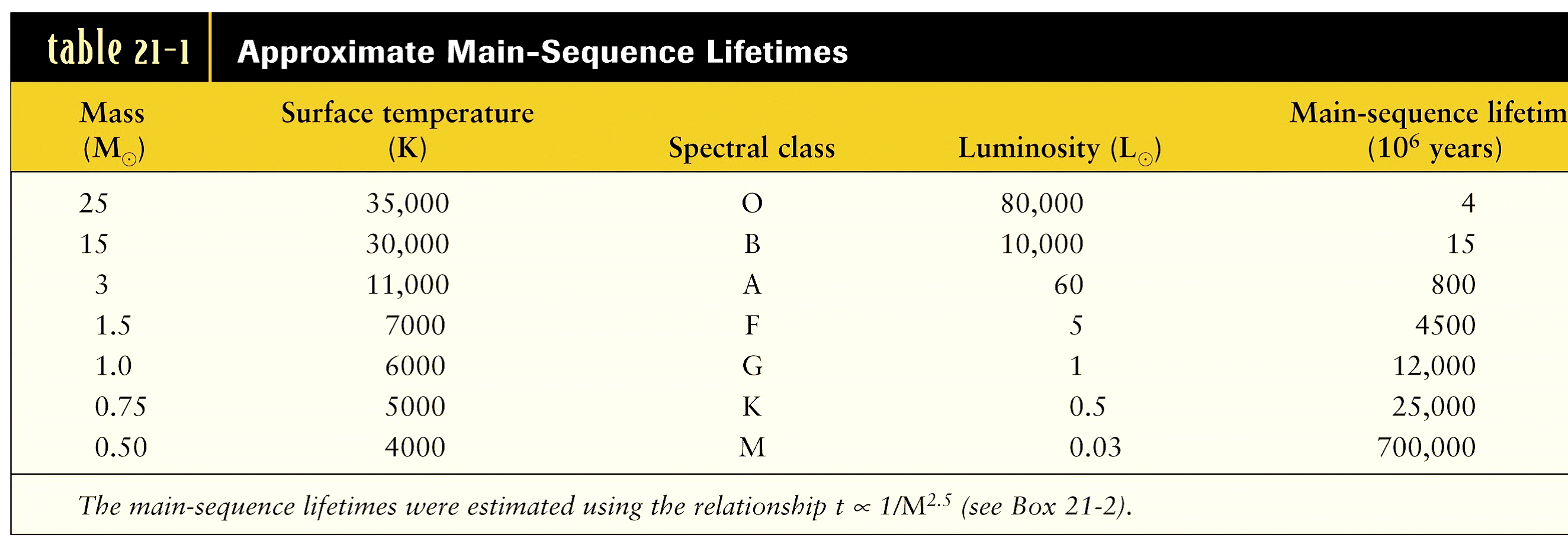 Source: P. Armitage
Source: P. Armitage
But what happens when the hydrogen runs out and they can no longer fuse hydrogen into helium to maintain the equilibrium between radiation pressure and contraction due to gravity? This too is determined by the mass of the star.
| Solar Mass Msun is the standard unit of Mass in stellar astronomy. It compares the mass of stellar objects to that of the Sun, which is about 2x1030 kg. Symbols used are Msun (as in this EBook) or M☉ . More here. |
Brown Dwarfs less than 0.08 Msun.
Although some of these “failed stars” may be big enough to fuse deuterium (a heavier isotope of hydrogen) into helium in some stage of their life, that will stop and they will cool gradually over trillions of years.
Red Dwarfs less than 0.1 Msun
They fuse hydrogen into helium while they are on the Main Sequence for trillions of years, but at some point their hydrogen will run out. But they are not big enough to fuse the helium into any other elements and they will end up almost entirely consisting of helium. Then they will slowly cool off. Because Red Dwarfs live so long, their decay has never been observed.
Low mass stars less than 0.8 Msun
They will swell up to a Red Giant star when the hydrogen outside the core starts to fuse (see below) but they are not hot enough to fuse helium. After the Red Giant stage they will collapse into a White Dwarf that is rich in helium.
Low mass stars less than 8 Msun
These stars (including our Sun) will go through a full Red Giant stage producing elements up to carbon and oxygen. They cannot fuse carbon and once the fusion stops they produce a planetary nebula while the core collapses to a White Dwarf that is rich in carbon and oxygen.
If the star has a mass of about more than 4 Msun the core temperature will be high enough for the fusion process to continue to produce Oxygen, Neon and Magnesium. The White Dwarf that then forms will be rich in these elements.
Massive stars more than 8 Msun
They will swell up to a Super Red Giant star and the fusion process can successively produce higher elements such as oxygen, sulphur and silicon. The more massive stars will fuse elements all the way up to Iron. Beyond this element, fusion cannot sustain itself as it will require additional energy. Once fusion thus ends the star will collapse to a supernova and the remaining core will either become a neutron star or a black hole.
The boundaries between these categories are not sharp and astronomers find many stars that have complex properties across some of these categories.
Below we will discuss the final stage of two main stages of post-main sequence stars in more detail.
Red Giants and White Dwarfs
Almost the title of a fairy tale but if it is, it is “fairly” dramatic. And a happy ending?
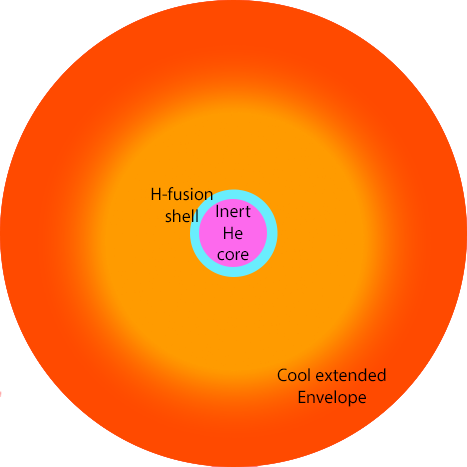 First Red Giant stage
First Red Giant stage
After a “low” mass star up to 8 times the mass of the Sun exhausts the supply of hydrogen in its core, there is no longer a source of pressure to support the core against gravity. The core of the star shrinks and therefore heats up, leaving an outer shell of hydrogen around it that now fuses to Helium. This causes the outer layers of the star to expand very much and rapidly. Due to this expansion the temperature in the outer layers decreases and the star becomes what is called a Red Giant star. Our Sun will become about two hundred times its present size and may even reach the orbit of the Earth.
The circular diagrams on this page and the next are inspired by the lecture "The Starry Dynamo".
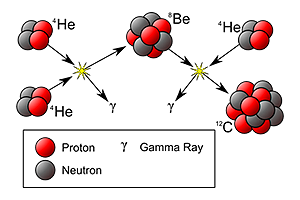 The triple-alpha process. Image: Wikipedia
The triple-alpha process. Image: Wikipedia
 He fusion has started in the core
He fusion has started in the core
Hydrogen continues to be fused to Helium around the already hot core and pressure keeps building up inside, until the Helium can start to fuse to Carbon and then to Oxygen in the so-called triple-alpha process. Although the core is now very hot, the outside of the star shrinks and gets fainter. The star now enters the “Horizontal Branch Phase” (more below)
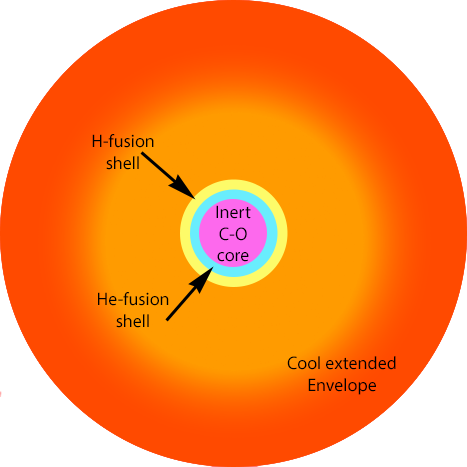 Second Red Giant stage
Second Red Giant stage
When the helium in the core runs out after about 100 million years, the core now mostly Carbon and Oxygen, shrinks and increases in temperature. Helium continues to fuse in a shell around the core. Remaining Hydrogen in the outer shell continues to fuse to Helium. The star grows rapidly for the second time to a larger Red Giant.
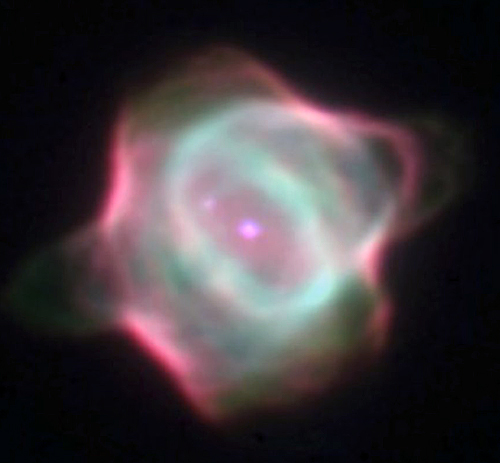 Stingray Nebula (Henize 1357). Source
Stingray Nebula (Henize 1357). Source
Planetary Nebula
The helium fusion around the core is unstable and the star pulsates, expelling a lot of material from the outer layers. leaving behind a hot core embedded in a nebula of expelled gas. Radiation from this hot core will ionise the nebula, producing a Planetary Nebula. The exposed core is now rich in Carbon and Oxygen and becomes extremely hot. It collapses as there is no nuclear fusion to sustain its size, and becomes a White Dwarf.
When the star is larger than 4 Msun and after the helium in the core runs out, the core temperature can be high enough to continue fusion to Oxygen, Neon and Magnesium (see next chapter).
The Stingray Nebula (Henize 1357) is the youngest known planetary nebula. Twentyfive years ago it was not hot enough to glow as it does today.
|
One of the most beautiful planetary nebulae Watch it in various wavelengths on video here |
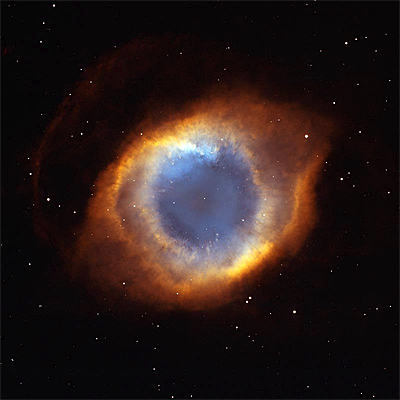 |
Electron degeneracy
The remaining White Dwarf is extremely dense and will pack about the total current mass of the Sun into an object the size of the Earth. Further collapse is prevented by electron degeneracy pressure, which is a state of matter in which atoms are packed together to a minimum volume.
According to the Pauli Exclusion Principle electrons with the same "spin" are not allowed to occupy the same energy level. Since there are only two ways an electron can spin, only two electrons can occupy a single energy level. In a normal gas there aren't enough electrons to fill up all the energy levels. But when gravity collapses the core into a white dwarf, the density is so high, that all the energy levels in the atoms are filled up with electrons. This is called a “degenerate” state. So the White Dwarf becomes stable against gravity, not by nuclear fusion, but by quantum mechanical principles that prevent its further collapse.
There is however a limit to what electron degeneracy can take. When the total mass of the core exceeds about 1.4 Msun there will be a catastrophic further collapse. This critical value of 1.4 Msun is known as the "Chandrasekhar limit." (More on that below).
White Dwarfs are below the Chandrasekhar limit and are thus stable. They start as very hot objects, but will cool down very slowly, because they do not generate further energy and will eventually become invisible Black Dwarfs. That will take trillions of years.
Super Giants and Neutron Stars
Massive stars have a lot more hydrogen to fuse, so it is a bit counter-intuitive that they have much shorter lifetimes than low mass stars. But they fuse much faster and are therefore much hotter and brighter. Therefore they run out of nuclear fuel earlier than slow fusing low mass stars. They also perish more dramatically when the fusion runs out.
| There is no sharp definition of a “massive” star, but it generally means a star with a mass of more than 4 Msun. There is a practical upper limit to the mass of a star. A star that is more massive than about 120 Msun will expel its outer layers by the extreme radiation until it becomes less massive. They will continue to shine as very bright blue giant stars. More here. |
 |
Beta Centauri (the blue one of the two "pointers" in the Southern sky, left in the image) is a very luminous star of spectral class B1. It is 8 times the size and 15,000 times the luminosity of our Sun. |
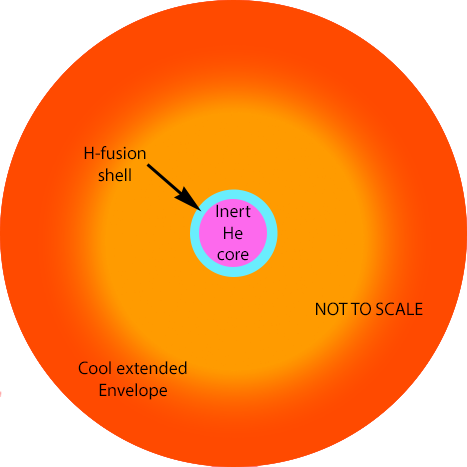 Red Supergiant
Red Supergiant
Initially the end stage in the life of a massive star is very similar to that of a less massive star as described above. Hydrogen in the core runs out, but will start fusing in a shell around the core. The star swells up to form a Red Super Giant.
Famous examples are the stars Betelgeuse in Orion and Antares in Scorpius.
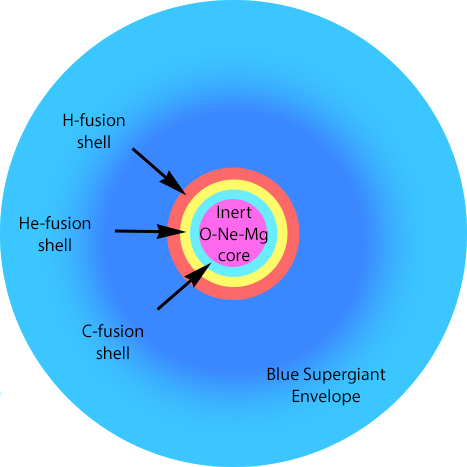 Blue Supergiant
Blue Supergiant
Helium starts to fuse in the core to produce Carbon and Oxygen. The star becomes a Blue Super Giant that is larger and hotter than the previous phase.
When the Helium in the core is exhausted the temperature will increase to something like a billion degrees. Under these conditions (in contrast to lower mass stars discussed on the previous page), the Carbon will now fuse to form nuclei of heavier elements such as Neon, and Magnesium. When the carbon in the core runs out, more carbon, helium and hydrogen will be fusing in concentric shells around the core.
 Supernova remnant Cassiopeia A observed by the Chandra X-ray Observatory Credit
Supernova remnant Cassiopeia A observed by the Chandra X-ray Observatory Credit
What happens now depends on the mass of the star
When the star’s mass is less than 8 Msun the envelope around the star will be thrown off in a planetary nebula and the core will collapse to a White Dwarf, but now mostly made up of Oxygen, Neon and Magnesium.
Stars with larger mass than 8 Msun will continue with fusion processes in the core.
Neon, Oxygen and Silicon will go through a range of very fast fusion reactions that stop in the core only when finally Nickel (Ni) and Iron (Fe) are produced. Beyond Iron a fusion reaction will not generate but consume energy and this is the natural end stage of fusion in the immensely hot core. These processes do not last more than a few years. The Silicon fusion last only about one day. When that stops the scene is set for disaster.
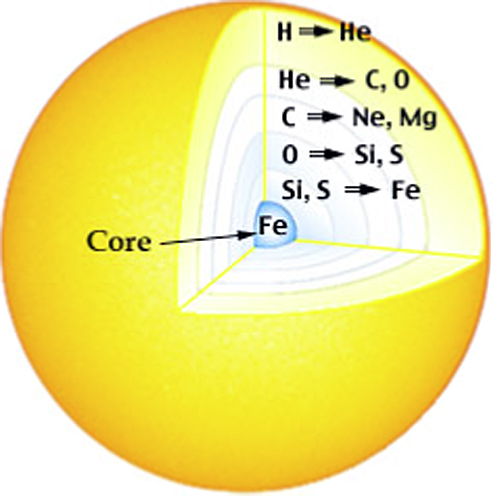
In less than a second, the core collapses from a diameter of about 6000 kilometres to less than 50 kilometres - the collapse happens so fast that the outer layers have no time to react or to collapse along with the core. The electrons in the atomic structure are forced into the atomic nuclei where they combine with protons and become neutrons and neutrino’s. The neutrinos radiate off at speeds near the speed of light, generating further nuclear reactions in the star’s outer region. The core bounces and meets the infalling gas head on. This generates a shock wave that we observe as a supernova. Instantly new fusion reactions produce heavier elements than Fe, enriching the supernova remnant. Some of those are unstable and decay immediately to lighter elements.
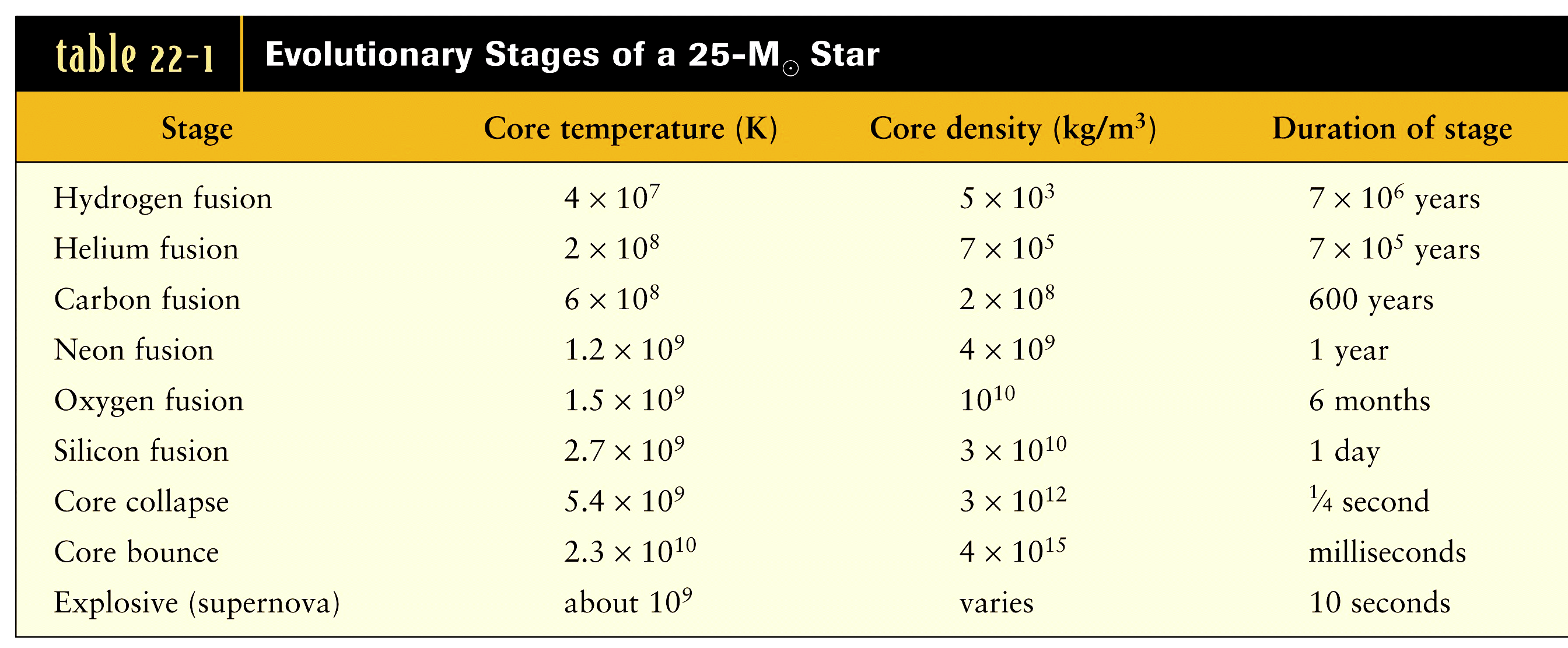 Source: P. Armitage
Source: P. Armitage
A Neutron Star is formed
If the collapsing Iron core is not too big the neutrons resist further compression by neutron degeneracy pressure, in a way that is analogous to electron degeneracy pressure (see above ), but much stronger; the atomic nuclei cannot be packed more densely together. The amount of compression relates to the difference between the size of an atom (including the electrons) and the size of the bare nucleus. This can be a factor in the order of 100,000. The density reaches that of atomic nuclei: one teaspoon of it could weigh a billion tons.
Further reading
R. Pogge, lecture The Structure & Evolution of Stars
Observing Neutron Stars (Pulsars)
Because the core is shrinking enormously when the neutron star forms, the initial rotation can speed up to as much as several hundred rotations per second. Many neutron stars emit strong EM-radiation that makes them detectable when the observer (on our planet Earth) happens to be in the path of the beam, like watching a lighthouse. Historically these emitting neutron stars were called Pulsars.
 Jocelyn Bell in 1967
Jocelyn Bell in 1967
The first pulsar was discovered in 1967, by Jocelyn Bell Burnell and Antony Hewish of the University of Cambridge, UK. When they used a radio antenna array to study signals from quasars, they found a very regular radio signal, consisting of pulses of radiation at a rate of one in every few seconds. This could not be an Earth based signal because the time it took the signal to reappear was a sidereal day and it was thus linked to the movement of the stars in the sky.
It seemed very unnatural to receive such a perfectly regular signal from space and for some time it was suggested that it could originate from extra terrestrial intelligence. The object was dubbed “LGM-1” for “Little Green Men”.
|
They debated this possibility and decided that, if this proved to be correct, they could not make an announcement without checking with higher authorities. There was even some discussion about whether it might be in the best interests of mankind to destroy the evidence and forget it!". Cartoon DanBee's Doodles (edited) |
The more scientific name pulsar, as a contraction of "pulsating star",
came into use when more of these objects were detected.
The first pulsar that Bell detected, emits in radio wavelengths, but other pulsars have been found that emit in the X-ray or Gamma ray wavelengths.
 The Vela pulsar, which spins 11 times a second, is the brightest persistent source of gamma rays in the sky. Credit: Roger Romani (Stanford University), et.al.
The Vela pulsar, which spins 11 times a second, is the brightest persistent source of gamma rays in the sky. Credit: Roger Romani (Stanford University), et.al.
Astronomers now know that pulsars are actually neutron stars that result from a supernova explosion. Neutron stars not only have an extreme gravity field but also a very strong magnetic field, that together with the fast rotation produces blizzards of high energy particles, causing narrow beams of strong radiation in many different wavelengths, from radio to Gamma ray.
The famous Vela pulsar is a neutron star, remnant of a massive star that went supernova about 10,000 years ago. The pulsar's electric and magnetic fields accelerate particles to nearly the speed of light, producing strong x-ray emission and a powerful jet from the polar region that are observed by the Chandra X-ray telescope.
Another famous neutron star is at the centre of the Crab Nebula. That is a remnant of a supernova explosion in recorded history (in the year1054). It rotates about 30 times per second and emits radiation across the entire EM spectrum. Watch the movie here.
Black Holes – worst case
If the iron core remnant of a collapsing massive star is more massive than about 3 Msun, even neutron degeneracy pressure cannot withstand the force of gravity. Actually, no known condition in the Universe can withstand such forces. The star collapses and continues to collapse. It forms a black hole. Matter disappears from contact with the rest of the Universe in a gravitational warp in space. We have no physics to explain the state of matter inside a black hole, rather than considering it as a gravitational singularity.
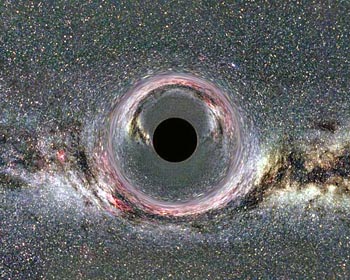 Black Hole warping space around it. Artist impression. We can talk about a surface, but not in the usual sense of the word. There is a region, or boundary in space-time around a black hole beyond which we cannot see. This boundary is called the event horizon. It is an imaginary spherical surface surrounding a black hole, with radius equal to the so-called Schwarzschild radius (escape velocity equals the speed of light), within which no event can be seen, heard, or known about by an outside observer.
Black Hole warping space around it. Artist impression. We can talk about a surface, but not in the usual sense of the word. There is a region, or boundary in space-time around a black hole beyond which we cannot see. This boundary is called the event horizon. It is an imaginary spherical surface surrounding a black hole, with radius equal to the so-called Schwarzschild radius (escape velocity equals the speed of light), within which no event can be seen, heard, or known about by an outside observer.
No visible light, nor X-rays, nor any other form of electromagnetic radiation, nor any particle, no matter how energetic, can escape from below the event horizon. The radius of this imaginary surface (proportional to the mass) is very small, only about 30 kilometres for a non-spinning black hole with the mass of 10 Msun.
The type of Black hole that results from the collapse of a single star is called a Stellar Black Hole. The mass of a black hole will increase when it captures mass from objects that come too close. The radius of the event horizon will increase by about 3 kilometres for every solar mass that it swallows.
| A black hole in the centre of a galaxy, where stars are densely packed, may grow to the mass of a billion Msun and become what is known as a Super massive Black Hole. These are not related to the stellar evolution we discuss in this EBook. |
Observing black holes
A black hole itself is invisible but its presence can be revealed through interaction with other matter.
One can see gas falling into a black hole from a companion star in a binary system. This gas spirals inward forming an accretion disk around the black hole, and heats up to very high temperature and emitting very strong X-ray radiation that can be detected. Many bright X-ray binary sources have been discovered in our galaxy and nearby galaxies.
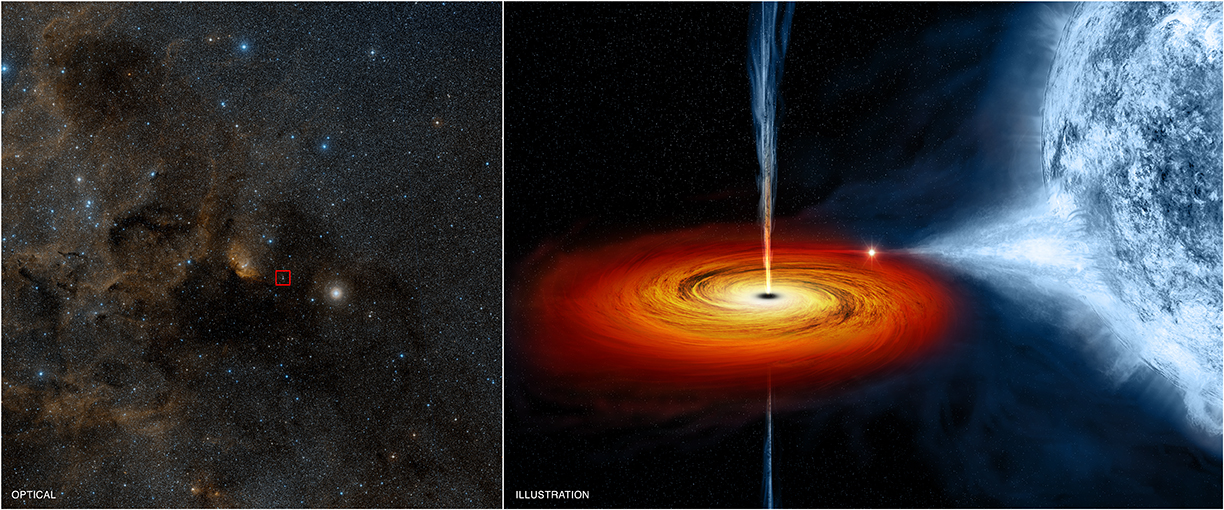
A well studied example of such a binary system involving a stellar black hole is Cygnus X-1 an X-ray binary system at a distance of about 6000 light years. It includes a blue super giant star which orbits a common centre of mass at about 0.2 AU, or 20% of the distance from the Earth to the Sun. The invisible central object is believed to be a black hole with a mass of about 8 Msun. Cygnus X-1 is a widely studied object because of its relative proximity.
Stellar wind from the giant star provides material for an accretion disk around the X-ray source. Matter in the inner disk is heated to millions of degrees, generating the observed X-rays.
More info and image credit here.
Further reading:
http://astronomy.swin.edu.au/cosmos/S/Stellar+Black+Hole
https://en.wikipedia.org/wiki/Black_hole
Supernovae classification
Basically there are two types of Supernovae (SN), Type I and Type II. Type I have no Hydrogen emission lines in their spectrum and Type II do.
But it is actually a bit more complicated and the names are largely historic as often in astronomy. In this case it is because of the significant improvement in spectroscopy with which the chemical composition of the remnants can be analysed.
 Image source
Image source
It has now been realised that we must distinguish in fact three different type I supernovae, now labelled IA, IB, and IC. Only type IA SN’s are caused by the explosion of a White Dwarf star in a binary system when it exceeds the Chandrasekhar limit. It is characterised by the presence of Silicon absorption lines in the spectrum.
The others, type IB and IC are like type II, the result of a core collapse of a giant star. The difference between these core-collapse SN classes are related to whether they have Hydrogen and Helium in their spectra.
Type IB has Helium in its spectrum because the exploding star has retained its Helium envelope, but no Hydrogen. Type IC lacks Helium in its spectrum and has lost both its Hydrogen and Helium envelopes prior to the explosion. Type II supernovae have both Hydrogen and Helium in their spectrum.

Accurate spectra can be best obtained when the supernova is at its brightest. Sometimes SN spectra change over time and thus appear to change type. This is understood to be caused by the expanding material catching up with envelopes of previously ejected material.
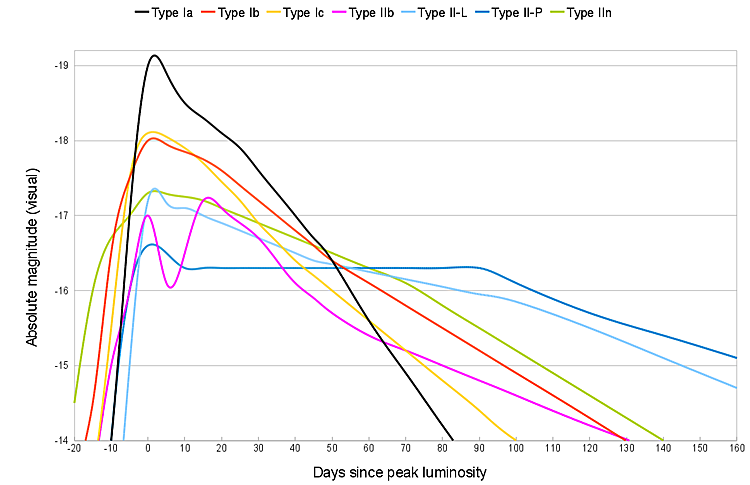 Supernova type light curves. Ref: Lithopsian
Supernova type light curves. Ref: Lithopsian
It is even more complex
Modern research increasingly blurs the distinction between Type II and Type Ib and Ic supernovae. Key aspects of modern observations are to observe the transient events in many different parts of the EM-spectrum (especially X-ray and Radio frequencies are very important) and to try to detect these events as early as possible, preferably before the main outburst (image).
Observatories such as PANSTARRS (Panoramic Survey Telescope and Rapid Response System located at Haleakala Observatory in Hawaii), and the Zwicky Transient Facility, a 47 square degree field of view telescope at Mount Palomar are providing early response observations.
One of the latest discoveries (since date of this publication) is the AT2018cow supernova, observed in June 2018 and dubbed “the cow”, that has baffled astronomers. It is both very luminous and very short lived and the jury is still out on the precise nature of this event.
Further reading:
http://astronomy.swin.edu.au/cosmos/S/Supernova+Classification
Core-collapse Supernovae
 Supernova remnant Cassiopeia A observed by the Chandra X-ray Observatory. Credit: NASA/CXC/SAO/Rutgers/J.Hughes
Supernova remnant Cassiopeia A observed by the Chandra X-ray Observatory. Credit: NASA/CXC/SAO/Rutgers/J.Hughes
As we saw above, a core-collapse supernova is the result of the collapsing core of a large mass star, when its nuclear fuel runs out and the core is no longer able to support itself by the electron degeneracy pressure of the core material. The collapse can reach velocities of 70,000 km/s and is suddenly halted by the neutron degeneracy pressure when the core mass is small enough and a neutron star forms. The ensuing shock wave sweeps up an expanding shell of stellar material which is observed as a supernova remnant.
The Crab Nebula in the constellation Taurus (already discussed above in the chapter on Pulsars) is a supernova remnant from a bright supernova recorded by Chinese astronomers in the year 1054. The nebula was the first astronomical object identified with a historical supernova explosion.
The released gravitational potential energy during core collapse is unimaginable - more energy than is produced by 100 stars like the Sun during their entire lifetimes. Most of the energy released during collapse is carried off into the outer regions of the star by neutrinos and absorbed by nucleosynthesis and kinetic energy; however a relatively small fraction of the energy triggers the accompanying Core-collapse supernova explosion. Luminosity can peak at ten billion Lsun and temporarily outshine the entire host galaxy.
| The word “Nova” comes from the Latin word for “new.” Plural is Novae. Observers initially thought such objects to be a new star, hence the name. |
What happens in detail is dependent on the mass of the collapsed core, its degenerate state and on the metallicity of the progenitor star.
Metallicity is a measure of the abundance of chemical elements other than hydrogen and helium in a star. Stars with low metalicity are generally old stars lacking enriched material from stellar explosions.
The released energy triggers many different processes of nucleosynthesis that forges heavier chemical elements, although much of those may subsequently disintegrate. Generally supernovae are thought of as the source of most heavier elements above Iron (more below). This heavy element enriched gas can be incorporated into future generations of stars and planets.
If the collapsed core is larger than about 3 Msun neutron degeneracy pressure is not enough to prevent further collapse, and a black hole forms. Often this does not generate a supernova at all. But if a black hole forms later caused by in falling material into the core, a super bright supernova may occur.
Core-collapse supernovae are very complex and subject to much ongoing research. Main factors to observe are the variations in the observed spectra and the duration of the whole event.
One of the most observed supernova is 1987a in the Large Magellanic Cloud then went off in 1987 (actually that is when it was observed; it went off 160,000 years earlier, because of the finite speed of light we saw it that much later) and has been observed ever since.
To watch:
time-lapse video https://www.youtube.com/watch?v=x-3BEnioClU
a tour of 1987a https://www.youtube.com/watch?v=ITvAdZzNFb0
Thermal Runaway Supernovae
The majority of stars have a companion and form a so-called binary system. Each of these companions will have the same age like twins, and it is likely that they will reach their final stage at about the same time. Therefore a white dwarf quite often has a companion star that is still in the red giant phase.
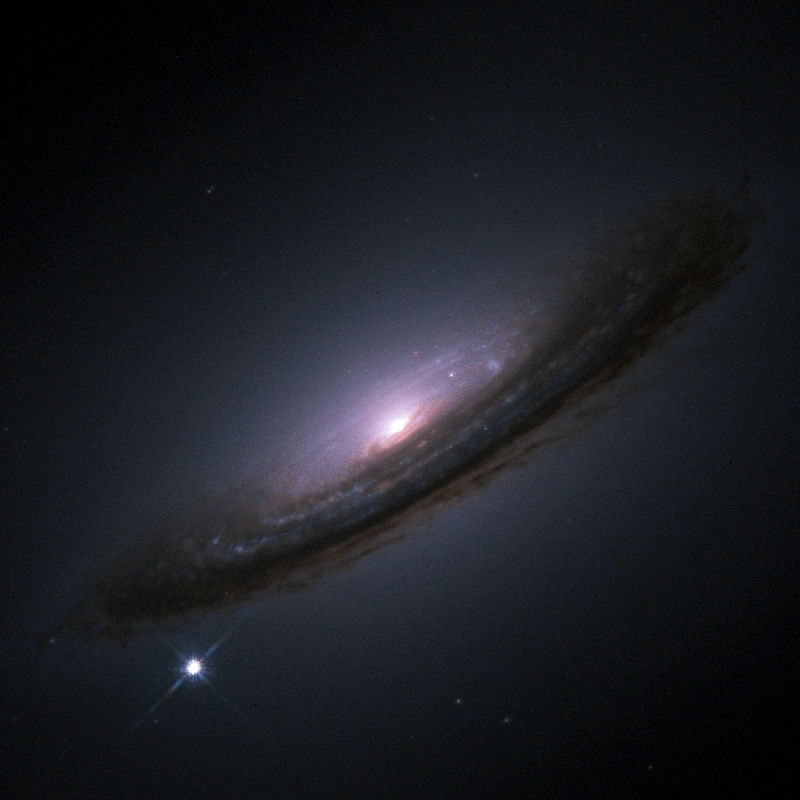 Image of SN 1994D, a type Ia supernova,
Image of SN 1994D, a type Ia supernova,
outshining its home galaxy NGC 4526. Source
Then material can be accreted by the white dwarf from its companion due to its very strong gravity, causing an increase in mass. If enough mass is accreted to bring the total mass over the Chandrasekhar limit, the equilibrium in the white dwarf is lost and the white dwarf will collapse to a neutron star. The modern view is that the supernova already occurs before this core collapse, as it is triggered by a sudden run-away fusion of carbon of which the white dwarf has plenty.
These type IA supernovae have a characteristic light curve (luminosity as a function of time). Especially the peak luminosity is very consistent for this class of supernovae. This makes them very important for measuring distance. Measuring the apparent brightness (as we observe it) and comparing that with the actual luminosity that we know for this type of supernova, can lead to accurate calculation of the distance to their host galaxy.
(More about this in our EBook “Stellar Distance”).
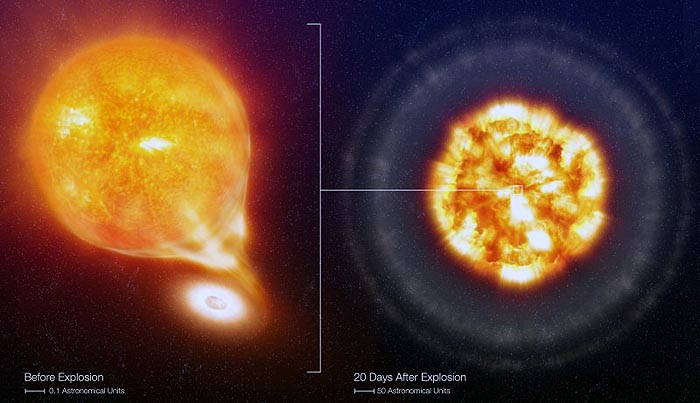 |
|
| Artist's impression of Type IA Supernova SN2006X | |
| Left: The White Dwarf (bottom right) accretes material from the Red Giant star, through a so-called accretion disk which surrounds the compact star. The Red Giant star has a radius about 100 times larger than our Sun, while the White Dwarf is about 100 times smaller than the Sun. | Right: Once the mass of the White Dwarf has reached the Chandrasekhar limit, the core collapses and a shock wave completely disrupts the star, ejecting its material into space with velocities up to a tenth of the speed of light. Twenty days after the explosion, when the supernova reaches its maximum brightness, the ejected material has reached a size of roughly 450 times the distance from Earth to the Sun. The enormous amount of light emitted by the supernova reveals gas shells which were ejected by the Red Giant in the last few hundred years before the explosion. |
| Credit: ESO, European Organisation for Astronomical Research in the Southern Hemisphere. | |
Mapping Stellar Evolution (HR-diagram)
Above and in our EBook Stellar Radiation we introduced the Hertzsprung-Russell diagram which plots stars according to their temperature versus their luminosity. If you haven’t worked with the HR-diagram before, we strongly suggest to go back to the EBook Stellar Radiation, pages 14 – 16, before continuing here.
 Hertzsprung-Russell diagram (derived from this lecture)
Hertzsprung-Russell diagram (derived from this lecture)
We saw that stars appear only in specific regions of the graph, which thus tells much about these stars, such as mass and size. The HR-diagram is also a powerful tool to study the evolution of stars, which we will explain here.
As we discussed most stars appear in a more or less diagonal band across the diagram from bottom right to upper left. These are the stars in the Main Sequence which have a fairly strict relationship (correlation) between temperature and luminosity (hence the linear structure). These are the stars that are in the main phase of their existence, in which they fuse hydrogen into helium. But how did they get to the main sequence and what will happen when their hydrogen runs out? That is what we will discuss below. We discussed all of that in this EBook, but now we will see what these stages look like on the HR-diagram.
Entering the Main Sequence
All stars form out of collapsing clouds of gas and dust as we discussed earlier in this EBook. Such “stellar nurseries” will be relatively cool (as compared to stars themselves) but yet quite luminous because these clouds are very large and thus have a large light emitting surface. On the HR-diagram these star forming clouds will therefore be on the right hand side (cool) and about half way up on the luminosity scale.
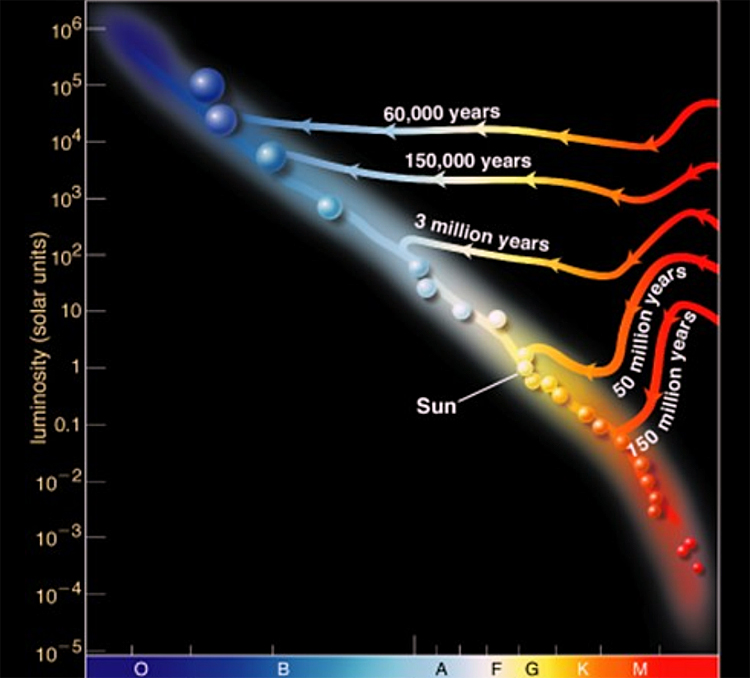 Entering the Main Sequence (image derived from here)
Entering the Main Sequence (image derived from here)
Once a proto-star collapses it becomes denser, the temperature goes up and the luminosity goes slightly down as the surface area decreases. So a forming star will move in the diagram from where the star forming region is to where it will end up on the main sequence (see image).
At that point the star is formed and the hydrogen fusion has started. As we discussed before, the star will then be relatively stable between self-gravity and radiation pressure from the fusion as long as there is enough hydrogen in the core.
Where the star ends up in the main sequence is entirely dependent on how much matter has collapsed, i.e. how massive the star is. We see the cool red dwarfs at the bottom right and the very hot blue stars in the upper left of the main sequence.
The mass of the star also very much determines how long a star will survive, as large stars fuse their hydrogen much faster and have a much higher temperature than smaller stars. So the location of a star in the main sequence gives a clear indication of both the mass of the star and of its expected lifetime.
Leaving the Main Sequence
Sun-like stars
Let us first follow the sequence for a Sun-like star. The diagram shows where the star ends up in the main sequence (1). Once the hydrogen in the core runs out and has been mostly replaced by helium, the core collapses which then heats the outer layers of the star, causing hydrogen to start fusing in a shell around the core and the formation of a Red Giant star as we discussed before. This becomes cooler on the outside (moves to the right in the diagram) and the luminosity increases because the surface area increases, so it also moves up in the diagram (2).
When the helium in the core starts fusing (2) (sometimes referred to as "Helium Flash") the star gets hotter but slightly less luminous and it follows the “Horizontal Branch” to the left (3). When after about 100 million years the helium in the core runs out the star swells due to both hydrogen and helium fusion in shells around the core and it follows the “Asymptotic Giant Branch” back to the right and at higher luminosity (4).
When the Helium fusion becomes unstable the core separates from the star’s envelope (4), producing a planetary nebula. At that point the core that has shrunk to the electron degenerate state, becomes exposed. It is very hot so it moves to the far left. Because of the collapse the luminosity goes down, so we see the resulting white dwarfs in the lower left of the diagram, very hot but low luminosity (5). Eventually and very slowly they will cool down and follow a path towards the right and also further down in luminosity, until they disappear at the bottom right off the diagram as a black dwarf, and into oblivion. The latter could take ten trillion years.
Giant stars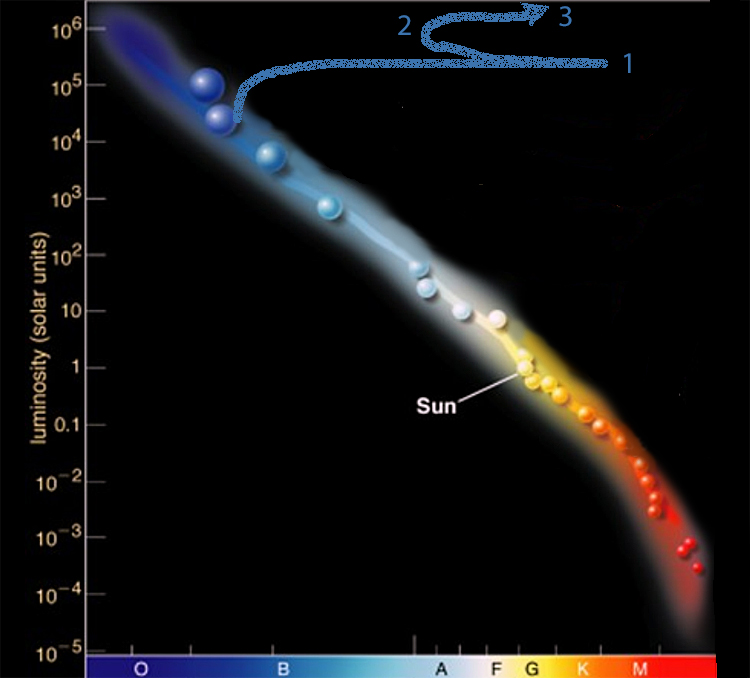
If the star is much bigger than our Sun, it will end up on the main sequence further to the left, with higher luminosity and higher surface temperature. It will stay there much shorter as the rate of fusion is much higher. When the hydrogen in the core runs out it will swell to a Red Super Giant (1). It is much more luminous than an ordinary Red Giant, but still relatively cool at the surface.
When Helium starts to fuse to Carbon and Oxygen in the core the star swells again and the surface temperature goes up. It becomes a Blue Super Giant (2). When the helium in the core is exhausted and starts to fuse outside the core, the star swells up and thus becomes more luminous. It becomes a Red Super Giant again (3).
As we discussed before large mass stars can continue fusion all the way up to Iron.
Ultimately the Iron core will collapse and a supernova will occur. Because the remnant of the star is incredibly hot and luminous it will disappear off the diagram far above the top left. The temperature can go up to trillions of degrees K and the luminosity to billions of main sequence stars combined. So the exposed core is literally way off the HR-diagram from the top left. The remnant core forms a neutron star which is incredibly compact and thus has very low luminosity, but extremely high temperature. Hence neutron stars will be off the diagram to the far lower left. If the mass of the remnant core is big enough a black hole will form as we discussed before. A black hole by definition has zero luminosity so it will be on the bottom axis but far to the left. So for big stars that ultimately become neutron stars or black holes, only the main sequence part up to the Red Super Giant stage on the HR-diagram is of any relevance.
Work with the interactive HR-diagram here
Watch a basic but good lecture here
A great tool
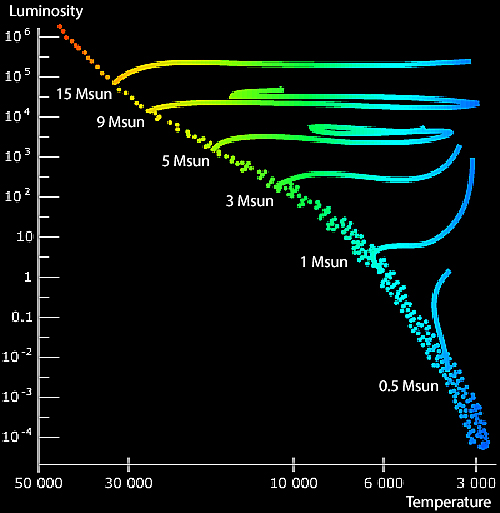 Final Stage for stars with various mass. Credit (edited)
Final Stage for stars with various mass. Credit (edited)
Astronomers studying stellar evolution make extensive use of the HR-diagram because similar stars occupy the same areas on the diagram during their evolution. Once a particular star is located on the diagram, much of its characteristics and also its evolutionary history are known.
The image shows the final stage of stars with various mass, from 0.5 Msun to 15 Msun. All stars move to the right while their surface temperature decreases. But the more massive stars maintain most of their luminosity and thus move horizontally. The most massive stars have an oscillating surface temperature as clearly shown in the diagram.
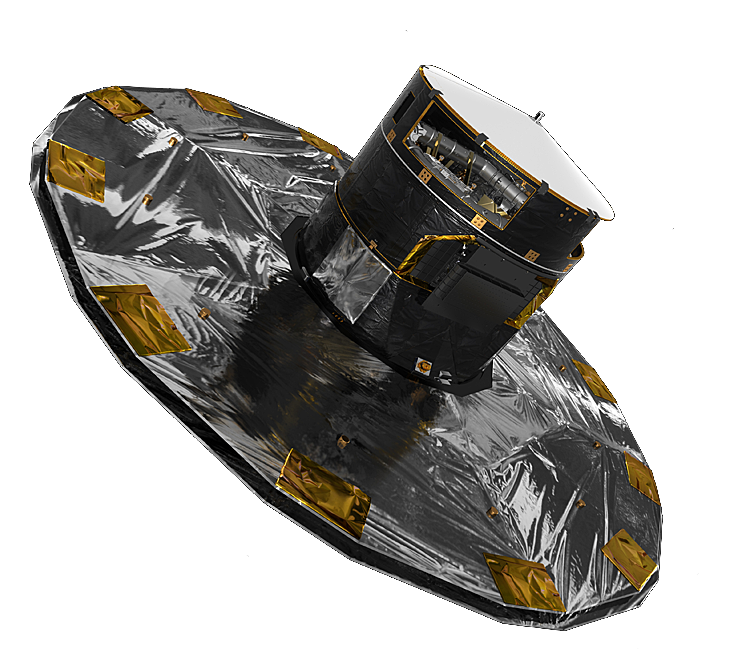 Gaia
Gaia
ESA’s Gaia spacecraft was launched in December 2013 and is located in the L2 Lagrangian Point on the shadow side of the Earth. Gaia performs three main types of observations: astrometry (stellar position, parallax, and proper motion), photometry (magnitude) and spectroscopy (for radial velocity and astrophysics).
This will allow classification of some billion stars in our entire Milky Way galaxy and will uncover not only stellar evolution and characteristics to unprecedented detail, but also clarify the origin and evolution of the galaxy itself.
More than four million stars within five thousand light-years from the Sun are plotted on this diagram using information about their brightness, colour and distance. The information is based on the second data release from the Gaia satellite. This Hertzsprung-Russell diagram, is the most detailed to date made by mapping stars over the entire sky.
Further Reading
Stellar Evolution and the HR-diagram
Cosmic Alchemy – How the elements are forged
We have already discussed some aspects of the nuclear fusion processes in stars during their lifetime and in the final stage. In this chapter we will review the formation of all the 92 elements that occur naturally in the Universe (and in our Solar system) in a systematic way. We will refer to the periodic Table shown here that explains the cosmic origin of the elements (click image for larger version in new tab).
| The Periodic Table lists the chemical elements according to increasing number of protons in the nucleus (atomic number). The table should be read like a book, from top to bottom and left to right. Hence the order of the elements is H, He, Li, Be, B, C, N, O, F, Ne, Na, Mg, Al, Si, P, S, Cl, Ar, K, Ca, Sc, Ti, V, Cr, Mn, Fe, etc. |
Big Bang NucleoSynthesis
In the early Universe soon after the Big Bang, matter in the form of fundamental particles, condensed out of the primordial energy. After about 380,000 years, atomic nuclei consisting of single protons or to some extend protons and neutrons, could bind electrons, thus forming the first atoms. Hydrogen (single proton and one electron) was by far the most common element (at about 75% by mass), with some Helium (up to 25%) and very little Lithium. This is why astronomers have the peculiar notion of calling all elements above Lithium “metals” as these were not formed in the Big Bang nucleosynthesis but were forged in early stars.
At the present day, the most common element in the Universe is still Hydrogen at about 74%. See Big Bang Fusion in the Periodic Table.
Dying low mass stars
When Sun-like stars end nuclear fusion in the Red Giant phase, the core collapse results in the throwing out of much material in the form of a planetary nebula. This nebula contains most of the material that was formed during the nucleosynthesis in the star (Helium, Carbon, Nitrogen and Oxygen), but the core collapse must also have triggered the instantaneous formation of many of the heavier elements that make it into the planetary nebula. That material is then available for future star formation.
Exploding massive stars
We discussed above that a massive star fuses up to Fe (Iron) up to its Super Giant stage. Then when the Super Giant’s core collapses it produces a core-collapse supernova, and a neutron star or even a Black Hole forms. This forges many of the heavier elements above Fe, although the modern view is that a large percentage of those elements is either destroyed during the actual explosion, or collapses with the core remnant (neutron star / black hole). So in the PT shown here we don’t see any heavier elements above zirconium (40) resulting from exploding massive stars.
Exploding White Dwarfs
We discussed the Type IA-supernovae explosions above, when a White Dwarf in a binary accretes material from the companion Red Giant, triggering runaway Carbon fusion and ultimately brings the star above the Chandrasekhar limit. Some of the medium heavy elements (up to atomic number 30) are expected to be formed during these events.
Merging Neutron stars
When two neutron stars merge from a binary couple, it must result in some of the most catastrophic (energetic) events in the Universe. (Astronomers are beginning to observe gravitational waves originating from such events). A large fraction of all heavier elements (above atomic number 40) is expected to be formed during these extreme events. It requires a very high concentration of neutrons in an extremely energetic environment to form these higher elements into stable nuclei (rapid neutron capture or r-process). Research on these processes is ongoing and there is no full consensus among astrophysicists. The more traditional view is that these heavier elements primarily result from core-collapse supernova explosions as discussed above.
Cosmic Ray fission (Spallation)
Cosmic Rays are not “rays” but streams of high energy particles in space. They consist of protons, proton-neutron combinations (nuclei of heavier elements) and also single electrons. When they collide with other matter and also mutually, they can form nuclei of some of the lighter elements such as Lithium, Beryllium and Boron. This fusion process called cosmogenic nucleosynthesis is held responsible for the observed abundances of these lighter elements. Some Lithium isotopes however are formed in dying low mass stars and also are primordial, originating from the Big Bang nucleosynthesis.
Read more on spallation here
Further reading
| The Periodic Table above is produced by Professor Jennifer Johnson and others (see Credit and further discussion of the shown Periodic Table here). Jennifer, at Ohio State University, is one of the leading experts on stellar evolution and the origin of the elements. Both aspects of astrophysics are actively researched and debated, and in some details the origin of the elements is still uncertain. |
Another Periodic Table discussion
For more in-depth information watch the interesting lecture series “Genesis of Heavy Elements” on Vimeo:
Anna Frebel
Ian Roederer
Hyung Mok Lee
We are made of the stars
| “The nitrogen in our DNA, the calcium in our teeth, the iron in our blood, the carbon in our apple pies were made in the interiors of collapsing stars. We are made of star stuff.” — Carl Sagan |
Without nucleosynthesis in stars and during explosive events discussed above, there would be no elements heavier than Lithium. Our discussion above explained the occurrence of the heavier elements in the Universe. The abundance of elements in our Sun and the gas planets, generally reflects those of the Universe at large. Astronomers know that our Sun has been formed from material that has gone through previous stellar lifecycles, including all of the processes discussed above. Because of the abundances of the heavier elements astronomers conclude that our Sun is a third generation star, made of cosmic material that must have gone through at least two previous stellar life cycles of massive stars.
However in the rocky planets like Earth, the abundance of elements has changed. Solar radiation has removed part of the volatile elements such as hydrogen, helium, neon, nitrogen and carbon (in methane). In the early stage when the Earth was liquid, heavier elements segregated towards the mantle and core, and many chemical processes, including biological ones on Earth, have changed chemical abundances as well.
If we take this personal and look at the human body, 24 of the naturally occurring elements are found in the human body. Eleven of those are significant and the other thirteen are trace elements. The latter does not imply that they are less important for life!
All of these elements have a cosmic origin. We are indeed made of stardust.
Further reading
https://askabiologist.asu.edu/content/atoms-life
Summary
As we saw, the mass of the star is the most important factor that determines its evolution. The diagram below illustrates stellar evolution of stars of increasing mass from bottom to top (Click image for source and larger version).
Summary of different outcomes in the final stage of stellar evolution.
|
|
Mass of End Stage |
Type |
Stable due to |
|
< 0.8 Msun |
< 1.4 Msun |
White Dwarf (He) |
Electron degeneracy pressure |
|
< 4 Msun |
White Dwarf (C, O) |
||
|
< 8 Msun |
White Dwarf (O, Ne, Mg) |
||
|
8 – 18 Msun |
1.4 – 3 Msun |
Neutron Star |
Neutron degeneracy pressure |
|
> 18 Msun |
3 - 20 Msun |
Black Hole |
No known force can withstand the gravitational pressure |
Explanations
• The limit of 1.4 Msun is called the Chandrasekhar limit.
• Electron degeneracy pressure is the resistance of electrons in atoms
against the collapse of the atomic structure
• Neutron degeneracy pressure Is the resistance of the atomic nucleus
after electrons have been crushed into it, forming neutrons and neutrino's
Typical values for size and Escape Velocity (function of mass)
|
|
Radius |
in speed of light (c) |
|
White Dwarf |
~ 6000 km |
~ 0.02 c |
|
Neutron star |
~ 10 km |
~ 0.7 c |
|
Stellar Black Hole |
< 30 km (event horizon) |
> c |
Explore:
Interactive guide to Stellar Evolution
Virtual trip to Black Holes and Neutron Stars
Further Reading:
Download stellar evolution story here


 -
-  Luminosity is the same as the power (energy per second) of a light bulb that we express in Watt. Astronomers use the term luminosity and express it in comparison to the luminosity of the Sun (Lsun). So a luminosity of 100 Lsun is a power of 100 times that of the Sun.
Luminosity is the same as the power (energy per second) of a light bulb that we express in Watt. Astronomers use the term luminosity and express it in comparison to the luminosity of the Sun (Lsun). So a luminosity of 100 Lsun is a power of 100 times that of the Sun. Astrophysicist Peter A. Sturrock writes that "when the first regular radio signals from pulsars were discovered, the Cambridge scientists seriously considered that they might have come from an extra-terrestrial civilization.
Astrophysicist Peter A. Sturrock writes that "when the first regular radio signals from pulsars were discovered, the Cambridge scientists seriously considered that they might have come from an extra-terrestrial civilization.
